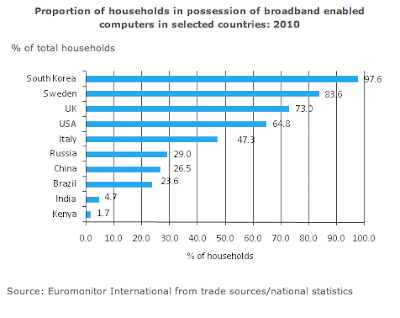Because Technology is contently changing it is also making the Digital Divide even larger than it already was. In the blog called, Euromonitor Global Market Research Blog, it has a post titled “Global Digital Divide persists but is narrowing”. The information in this blog was very shocking to me. I would have expected the Digital Divide to be widening instead of narrowing. In this blog post it discusses how although the Digital Divide remains a huge problem, things are being done to help decrease the gap. As expected people in developed countries in general are connected much better to the internet, than those people who are in developing countries. Although more consumers in developed countries have greater access to the internet, the number of users in developing countries is higher now, than it ever has been. All of this according to this blog post, “has broad economic implications, for instance on consumer spending habits and business opportunities, as well as social, political and cultural consequences” (euromonitor.com).
The reason for the Digital Divide seems to be most prevalent when it comes to comparing what kinds of resources developing countries have versus the resources that developed countries have. There are many things going on all around the world with different governments trying to decrease the gap that is caused by the Digital Divide. For example, “India said in December 2010 that it wanted to have all villages of more than 500 people connected to broadband Internet by 2013. Even in developed countries there are efforts to bridge local digital divides: in January 2011 the UK government announced a plan to offer £98 (US$151.9) laptops in an effort to get poorer and older consumers online”(euromonitor.com). It is not just America that is trying to get everybody connected to the internet. It almost seems as though the developing countries are trying harder to get everybody connected to the internet is any way shape or form. Where as in America and other developed countries the government is just more focused on getting everybody the next best thing. For example, this blog posts also states, “Future growth in the number of broadband users is expected to be concentrated in developing regions, given that penetration and usage rates are approaching maturity in more developed countries. For example, the number of broadband Internet subscribers is forecast to grow by an annual average of 46.6% between 2010 and 2020 in Nigeria, compared to 0.9% in Iceland” (euromonitor.com).
The problem of the Digital Divide effects many things. One big thing that it effects is the learning and the education of students all over the world. The information that is available on the internet provides a wide variety of resources to improve the students ability to learn. If the Digital Divide can continue to be narrowed it can help reduce the gap in education and literacy rates between developing countries and developed countries as well as between rural and urban areas. Although globally, the Digital Divide may be getting narrowed, In the United States there seems to be a growing Digital Divide. In a new study published by the Pew Internet & American Life Project , John B. Horrigan looks at Web 2.0 and America’s use of it. After analyzing this information he concludes that a good amount of Americans are embracing the new technology that is being offered but at the same time a good amount of people are not realizing what technology has to offer or are just choosing to ignore it and not participate. In this study he finds that, “31% of Americans are considered to be “Elite Tech Users”, where as 49% have few tech assets, either engaging with the online world only on occasion, or not at all”(techcrunch.com).
Overview | A Closer Look | Current Practices | Educational Impact | Solutions | Bibliography |


